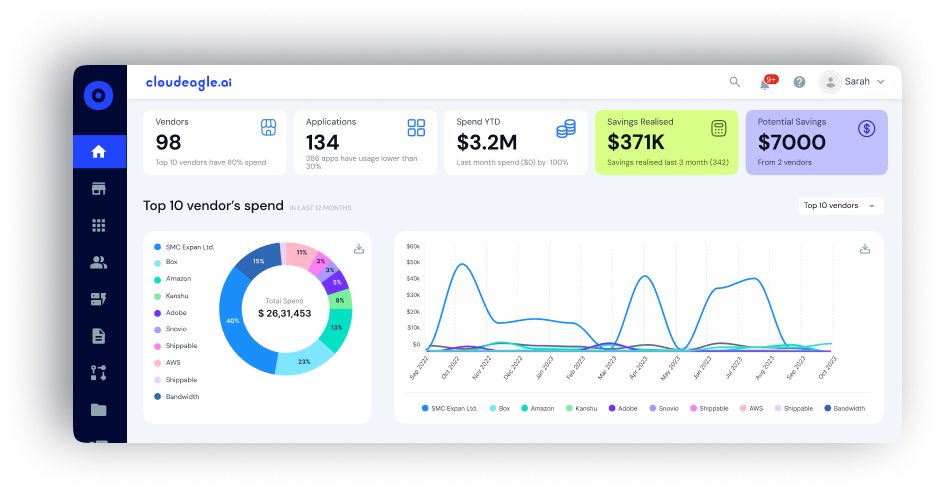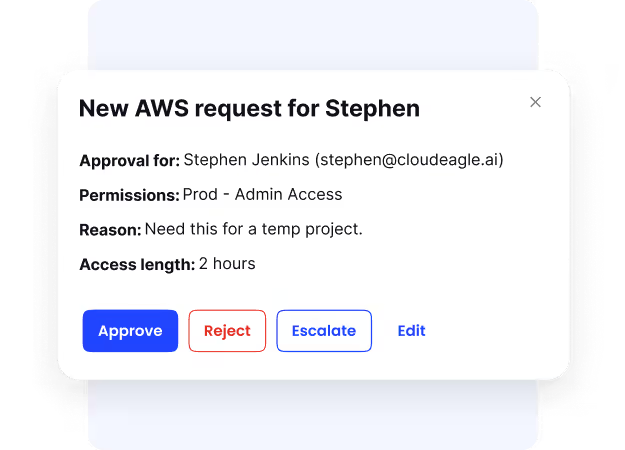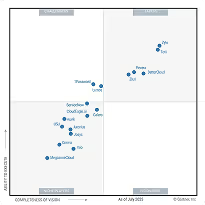HIPAA Compliance Checklist for 2025

Are you truly managing your SaaS applications effectively?
As enterprises increasingly rely on SaaS tools for their operations, ensuring their security and compliance has never been more challenging. With SaaS app portfolios growing, organizations face risks like unauthorized access, data breaches, and compliance failures.
In fact, 70% of organizations report that they have no visibility into all the SaaS applications being used across their business, which opens the door to security and compliance risks.
So, is there a way to stay ahead of this?
Yes, you can take action. This is where a SaaS Governance Tool becomes essential. These tools centralize the management of SaaS applications, helping to optimize their use while safeguarding your organization against security risks and regulatory issues.
Let’s explore what SaaS governance is, the key features to look for when selecting a governance tool, and how CloudEagle.ai can help streamline your SaaS governance.
TL;DR
- SaaS Governance Tools help manage, secure, and optimize SaaS apps, improving visibility, compliance, and access controls.
- Security teams need these tools to minimize risks like unauthorized access, data breaches, and non-compliance.
- Key evaluation criteria: discovery & inventory, access governance & automation, security features, contract intelligence, ease of integration, reporting, dashboards, and alerts.
- Steps to select: map gaps, shortlist vendors, request demos, score based on use cases, and review security/compliance posture.
- CloudEagle.ai offers a comprehensive platform to streamline governance, enhance security, and optimize SaaS costs.
Blog Video: https://www.youtube.com/@CloudEagle.aicommunity
What Are SaaS Governance Tools?
A SaaS governance tool is a software solution that helps businesses manage and secure their SaaS applications. With growing reliance on SaaS, these tools are crucial for protecting data, controlling costs, and ensuring compliance.
They provide a centralized platform to monitor the entire SaaS portfolio, automate processes, enforce compliance, and secure data access. Key features often include discovery, inventory management, access control, contract renewal management, and compliance enforcement.
These tools:
- Provide visibility into your entire SaaS stack for better control and decision-making.
- Ensure only authorized users can access specific applications and data.
- Help organizations stay compliant with regulations like GDPR, SOC 2, and HIPAA.
- Identify opportunities to reduce overspending and eliminate unused licenses.
- Streamline tasks like access reviews, contract renewals, and vendor management.
Why Security Teams Need SaaS Governance?
Security teams are responsible for protecting sensitive data, ensuring compliance, and guarding against cyber threats. As businesses increasingly rely on SaaS platforms, managing these tools becomes a growing challenge.
Here’s why SaaS governance is crucial for security teams:
1. Preventing Unauthorized Access: With numerous SaaS apps in use, it’s difficult to track who has access to sensitive data. SaaS governance tools centralize access management, allowing teams to monitor and quickly address any unauthorized access.
2. Eliminating Shadow IT: Unauthorized apps bypass IT control, creating security risks since they’re often unvetted for compliance or security. SaaS governance tools continuously scan and catalog all SaaS applications in use, helping identify and mitigate shadow IT risks.

3. Ensuring Compliance: Regulations like SOC 2, ISO 27001, GDPR, and HIPAA require businesses to handle and protect customer data properly. SaaS governance tools automate compliance checks, ensuring all apps meet necessary legal requirements and reducing the risk of costly fines.
4. Maintaining Data Security & Privacy: Vulnerabilities in SaaS apps can lead to data breaches. Governance tools provide features such as encryption, access control, and audit logs to protect data from cyber threats and ensure privacy.
5. Cost Management: SaaS governance tools help prevent overspending by tracking app usage, identifying unused licenses, and ensuring that only necessary apps are in use, optimizing resources, and reducing costs.
What Features You Should Look for in a SaaS Governance Tool?
When selecting a SaaS governance tool, it’s important to consider several key factors that ensure the tool aligns with your organization's security, compliance, and business goals.
Here’s what to look for:
1. Discovery & Inventory Coverage
Knowing what SaaS applications are in use is the first step in effective governance. A strong tool should automatically discover and catalog all SaaS apps across your organization, including those introduced through shadow IT or departmental purchases.
Key Features:
- Auto-discovery of SaaS apps
- Comprehensive inventory tracking
- Visibility across all departments and users
2. Access Governance & Automation
Effective access control is critical for security. The tool should allow role-based access control (RBAC) and automate user provisioning and deprovisioning to ensure the right people have the right access.
Key Features:
- Role-based access control (RBAC)
- Automated onboarding/offboarding
- Integration with IAM systems
3. Security & Compliance Features
To mitigate risks and meet regulatory requirements, the tool should have features like data encryption, audit logs, and automated compliance checks to protect sensitive data and ensure ongoing security.
Key Features:
- Automated compliance checks (e.g., GDPR, SOC 2)
- Data encryption and secure access controls
- Audit logs for tracking security and compliance
4. Contract & Renewal Intelligence
Managing renewals and contracts can often lead to overspending. A good tool helps track contract terms, manage auto-renewals, and negotiate better pricing with vendors.
Key Features:
- Contract management and renewal reminders
- Automated renewal workflows
- Vendor pricing benchmarking
5. Ease of Integration & Deployment
The tool should integrate seamlessly with over 500 SaaS apps, including your existing systems (IT, security, HR, finance), to ensure smooth data sharing and automated workflows, making deployment efficient and straightforward.
Key Features:
- Integration with IAM, ERP, and HR systems
- Seamless deployment with minimal configuration
- No-code or low-code interfaces for quick setup
6. Reporting, Dashboards, and Alerts
A good SaaS governance tool should offer customizable dashboards, real-time alerts, and detailed reporting to monitor app usage, track compliance, and optimize costs.
Key Features:
- Customizable dashboards and analytics
- Real-time alerts for security and compliance events
- Detailed reporting on SaaS usage and spend
How CloudEagle.ai Helps in SaaS Governance?
SaaS governance is no longer just about monitoring app usage; it's about enforcing policies, maintaining access controls, tracking vendor risk, and ensuring audit compliance across every corner of the SaaS stack, including AI-powered tools and unmanaged shadow IT.
CloudEagle.ai provides an all-in-one governance layer that integrates with your identity, finance, procurement, and security systems to ensure visibility, control, and compliance at scale.
Here’s how it helps with maintaining SaaS governance:
1. Unified SaaS & Shadow IT Discovery
CloudEagle.ai continuously discovers all SaaS and AI apps using data from SSO, finance tools, HRIS, and browser plugins; creating a full inventory, even for tools bypassing procurement.

How it helps:
- Uncovers hidden apps and unauthorized vendors.
- Prevents risk exposure from unmanaged tools.
- Gives GRC and IT teams full governance scope.
- Improaves data classification and policy enforcement.
- Establishes a foundation for access and compliance controls.
2. Automated Access Reviews
CloudEagle.ai automates your SOC 2 and ISO 27001 access reviews. With one centralized dashboard, you can manage user permissions, track access, and generate reports without logging into each app individually.
How it helps:
- Ensures compliance without manual effort.
- Saves time by auto-generating audit-ready reports.
- Reduces human errors in access management.
- Streamlines workflows and improves efficiency.
- Provides a clear audit trail for review.
Know how Dezerv automated its app access review process with CloudEagle.ai.
3. Centralized Role-Based Access Governance
CloudEagle.ai connects with your IDP and HRIS to automate access provisioning, deprovisioning, and periodic reviews, enforcing least privilege and zero trust policies across all apps.

How it helps:
- Reduces access creep and stale permissions.
- Simplifies quarterly and event-based access reviews.
- Enables JIT (just-in-time) and time-bound access.
- Provides full audit trails for all user access decisions.
- Aligns access control with job roles and compliance mandates.
4. Just-in-Time Access Management
CloudEagle.ai’s Just-in-Time (JIT) access feature ensures that users have access to sensitive systems only when they need them. This time-bound approach minimizes security risks by granting temporary access, which is automatically revoked once the task is completed.

How it helps:
- Minimizes security risks by granting access only when necessary.
- Saves licensing costs by providing temporary access, especially for contractors.
- Enhances compliance by enforcing least privilege access.
- Streamlines workflows with automated access and deprovisioning.
- Reduces manual effort by automating access management.
5. Self-Service App Catalog
CloudEagle.ai’s Self-Service app catalog lets employees to easily request access to the apps they need, streamlining the process and boosting productivity. Employees can search for approved apps and submit access requests directly through Slack or MS Teams, eliminating manual approval steps and reducing time spent accessing necessary tools.

How it helps:
- Instant access approvals via Slack save time for IT and employees.
- Requests are raised through Slack, with approvals in ServiceNow or JIRA.
- Temporary access is granted and revoked automatically, saving on licenses.
- Employees are encouraged to use existing apps, reducing unapproved software.
- Proper approvals are ensured before granting sensitive system access.
A Gen AI company streamlined saas access provisioning with CloudEagle.ai’s self‑service app catalog.
6. Vendor Compliance & Risk Management
Each app in CloudEagle.ai is scored by compliance status (SOC2, HIPAA, ISO), contract metadata, usage level, and security posture. Missing documents or high-risk vendors are flagged proactively.

How it helps:
- Provides vendor due diligence insights for audits.
- Reduces legal and compliance exposure.
- Surfaces risk trends across your SaaS portfolio.
- Keeps all vendor DPAs, SLAs, and contracts centralized.
- Enables continuous vendor risk monitoring.
What Are the Steps to Select the Right SaaS Governance Tool?
Choosing the right SaaS governance tool involves careful planning. Here’s how you can make the right choice:
1. Map Current Gaps: Evaluate your current SaaS governance setup to identify gaps in security, compliance, and cost management. Are you struggling with shadow IT or inefficient access controls? Recognizing these gaps will help define what you need from the new tool.
2. Shortlist Vendors: Based on your needs, create a list of potential vendors. Look for tools that support discovery, access governance, compliance, and cost control. Check for integration options and vendor support.
3. Request a Demo or Proof of Concept (POC): Request a custom demo or POC from each vendor. Testing the tool in real-world scenarios will help you understand how well it meets your governance requirements.
4. Score Based on Prioritized Use Cases: Rate each vendor based on how well they address your most important use cases. If security is your priority, look for vendors that offer strong compliance and access control features.
5. Review Security, Compliance, and Data Privacy: Check each tool’s security features, including compliance with regulations like SOC 2, ISO27001, HIPAA, and GDPR. Make sure the tool provides strong encryption and access controls to protect your data.
6. Align with Budget and Procurement Workflow: Ensure the tool fits within your budget and aligns with your organization’s procurement process. Consider both functionality and cost when making your final decision.
Check out this discussion with Jeremy Boerger, founder of Boerger Consulting and creator of the Pragmatic ITAM Method. With over 20 years of experience, Jeremy shares insights on how IT leaders can build more resilient, collaborative, and data-driven organizations.
Conclusion
As enterprises expand their SaaS usage, managing and securing this complex environment becomes increasingly vital. A SaaS governance tool provides the visibility, security, and compliance features needed to mitigate risks and optimize costs.
By selecting the right tool, security teams can ensure that SaaS applications are effectively governed, reducing the likelihood of data breaches, non-compliance, and unnecessary expenses.
If you're searching for a comprehensive solution, CloudEagle.ai is a great choice. It simplifies SaaS governance with an all-in-one platform that streamlines security, compliance, access management, and contract renewals.
Ready to take control of your SaaS governance?
Schedule a demo with CloudEagle.ai to manage SaaS governance in your enterprise.
FAQ
1. What is SaaS governance?
SaaS governance refers to the processes, policies, and tools used to manage and secure SaaS applications, ensuring compliance, controlling access, and optimizing usage across an organization.
2. What are the 5 key security elements of the SaaS model?
The key security elements include data protection and encryption, access control, compliance documentation, vendor monitoring, and continuous auditing and reporting.
3. What is GRC in SaaS?
GRC stands for Governance, Risk, and Compliance, which involves managing and aligning SaaS operations with organizational goals, mitigating risks, and ensuring adherence to regulatory standards.
4. What is SOC2 compliance for SaaS?
SOC 2 compliance for SaaS ensures that a SaaS provider meets security, availability, confidentiality, processing integrity, and privacy standards, safeguarding customer data.
5. What is ISO compliance for SaaS?
ISO compliance for SaaS, particularly ISO 27001, ensures that a SaaS provider has established and follows robust information security management practices to protect sensitive data.

%201.svg)










.avif)




.avif)
.avif)




.png)









